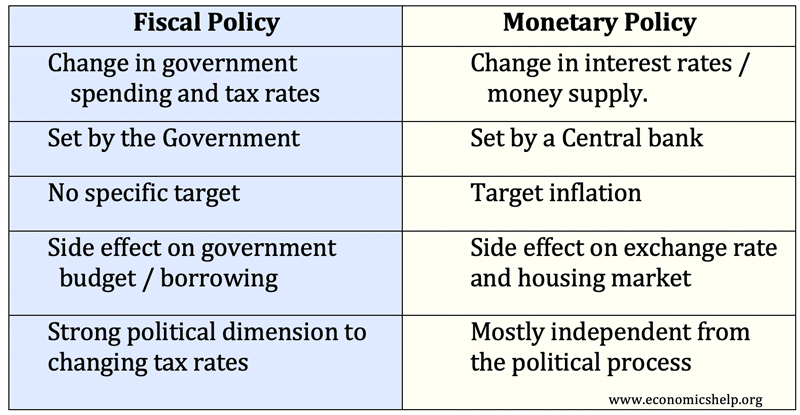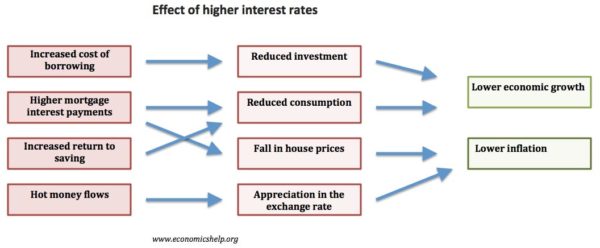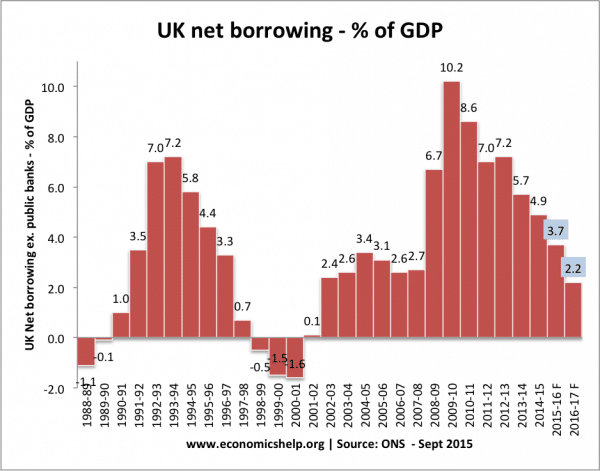Readers Question: What is the difference between monetary and fiscal policy?
- Monetary policy involves changing the interest rate and influencing the money supply.
- Fiscal policy involves the government changing tax rates and levels of government spending to influence aggregate demand in the economy.
They are both used to pursue policies of higher economic growth or controlling inflation.

Monetary policy
Monetary policy is usually carried out by the Central Bank/Monetary authorities and involves:
- Setting base interest rates (e.g. Bank of England in UK and Federal Reserve in the US)
- Influencing the supply of money. E.g. Policy of quantitative easing to increase the supply of money.
How monetary policy works
- The Central Bank may have an inflation target of 2%. If they feel inflation is going to go above the inflation target, due to economic growth being too quick, then they will increase interest rates.
- Higher interest rates increase borrowing costs and reduce consumer spending and investment, leading to lower aggregate demand and lower inflation.
- If the economy went into recession, the Central Bank would cut interest rates.
- See also: Cutting interest rates
Fiscal policy
Fiscal policy is carried out by the government and involves changing:
- Level of government spending
- Levels of taxation
- To increase demand and economic growth, the government will cut tax and increase spending (leading to a higher budget deficit)
- To reduce demand and reduce inflation, the government can increase tax rates and cut spending (leading to a smaller budget deficit)
Example of expansionary fiscal policy
In a recession, the government may decide to increase borrowing and spend more on infrastructure spending. The idea is that this increase in government spending creates an injection of money into the economy and helps to create jobs. There may also be a multiplier effect, where the initial injection into the economy causes a further round of higher spending. This increase in aggregate demand can help the economy to get out of recession.
This shows that in 2009/10 the UK ran a budget deficit of 10% of GDP. This was caused by the recession and also the government’s attempt to provide a fiscal stimulus (VAT tax cut) to try and get the economy out of recession.
See more at: Expansionary fiscal policy
If the government felt inflation was a problem, they could pursue deflationary fiscal policy (higher tax and lower spending) to reduce the rate of economic growth.
Which is more effective monetary or fiscal policy?
In recent decades, monetary policy has become more popular because:
- Monetary policy is set by the Central Bank, and therefore reduces political influence (e.g. politicians may cut interest rates in the desire to have a booming economy before a general election)
- Fiscal policy can have more supply side effects on the wider economy. E.g. to reduce inflation – higher tax and lower spending would not be popular, and the government may be reluctant to pursue this. Also, lower spending could lead to reduced public services, and the higher income tax could create disincentives to work.
- Monetarists argue expansionary fiscal policy (larger budget deficit) is likely to cause crowding out – higher government spending reduces private sector expenditure, and higher government borrowing pushes up interest rates. (However, this analysis is disputed)
- Expansionary fiscal policy (e.g. more government spending) may lead to special interest groups pushing for spending which isn’t really helpful and then proves difficult to reduce when the recession is over.
- Monetary policy is quicker to implement. Interest rates can be set every month. A decision to increase government spending may take time to decide where to spend the money.
However, the recent recession shows that monetary policy too can have many limitations.
- Targeting inflation is too narrow. During the period 2000-2007, inflation was low but central banks ignored an unsustainable boom in the housing market and bank lending.
- Liquidity trap. In a recession, cutting interest rates may prove insufficient to boost demand because banks don’t want to lend and consumers are too nervous to spend. Interest rates were cut from 5% to 0.5% in March 2009, but this didn’t solve recession in the UK.
- Even quantitative easing – creating money may be ineffective if banks just want to keep the extra money on their balance sheets.
- Government spending directly creates demand in the economy and can provide a kick-start to get the economy out of recession. Thus in a deep recession, relying on monetary policy alone, may be insufficient to restore equilibrium in the economy.
- In a liquidity trap, expansionary fiscal policy will not cause crowding out because the government is making use of surplus saving to inject demand into the economy.
- In a deep recession, expansionary fiscal policy may be important for confidence – if monetary policy has proved to be a failure.
Related



For those interested, I think one of the best running commentaries on what is happening in relation to the credit crunch (combined with some fresh and unconventional thinking on matters fiscal and monetary) is this: http://www.winterspeak.com/
Whoever writes this blog didn’t even know that the UK still retained the pound and was not part of the European monetary union, and was giving very misleading advice about the economy after Brexit, so I don’t think much of this recommendation.
Good article.
Part of Monetary policy, especially in the past, is control of the exchange rates and therefore value of the currency, which is worth noting.
This was of course before there were floating exchange rates. It’s much more difficult to do it nowadays, but a devalued pound has been the possibly beneficial consequence of the recession.
Surely increased government spending shifts demand rather than creates it? The money has to come from somewhere after all, and “thin air” is not one of the determinants of demand, at least last time I checked.
Both policies are useful and effective. But all depends on the demand and supply curve of the economy. If the demand curve is flat, where money policy is no longer efffective, then we need fiscal policy. Government must spend money to move the demand and the economy. On other side, if demand curve is elastic to interest rates, normally monetary policy works….
Sir i quiet agree with u,
both the monetory policy and the fisical policy are very effective to the development of a countries economics growth.
in principal all economic activity could be conducted through market transactions. how ever even in market economics much economic activity occurs within firms where administrative decisions rather than market prices are used to allocate resources
fiscal & monetary policy
The differences should be more specified.Anyway, both of these policies are needed to be implemented for the betterment of the economy.
In this present economic dynamics, both fiscal and monetary policy should be applied to the economy sparingly, to ensure that the consequences of the application does not have longer detrimental effect on the economy. This present global economic situation is indeed unique, and due care must be taken in solving the problems we encounter.
i appreciate the work done above.however,it could be better if more differences are shown.
Good article! 🙂 Especially for this internship Economists. 🙂 Differences are enough for a simple economist to understand 🙂
I agree with Ms. Evan Terese!
Do you have project topics on Problems of Monetary and Fiscal Policies?
i have a paper tomorrow and i understand it now what are the fiscal and monetary policy…….GOD bless you ….you may improve the work also
Describe the difference between monetary and fiscal policy in the UK and explain how such policies can be used to achieve different macroeconomic government objectives?
As economies continue to integrate due to globalisation and formally closed economies like India and China march toward total liberalisation, entrepreneurship is on the increase. A close analysis of developed and industrialised economies indicates a common denominator that stands out amongst all of them, which is the important role played by entrepreneurship and entrepreneurs in such economies. How entreprenuers impact an economy?
Reich (2010, p. 1) argues that economic growth leads to increased prosperity in the developed, emerging and developing world. Why do you think growth is good?
Wow.. I know understand the difference between monetary and fiscal policy… Everything here is vivid and straight forward
a great website
Very beneficial article. Good work.